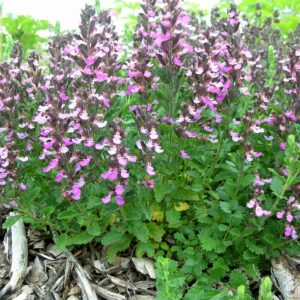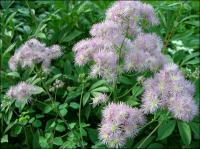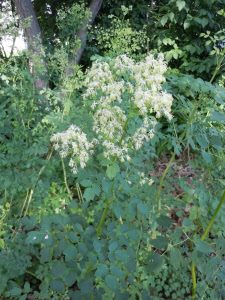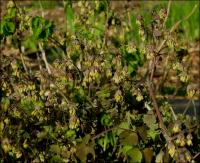Our Plants
Showing 569–576 of 616 results
-
Teucrium chamaedrys Wall Germander Z 5-9
Fragrant red-purple or bright rose flowers
Fragrant red-purple or bright rose flowers on this evergreen subshrub, July-September
Size: 1-2' x 12"
Care: sun in well-drained soil
Native: Caucasus MountainsTeucrium is named after Teucer, the 1st king of Troy. Chamaedrys means “ground oak” referring to foliage, like miniature oak leaves. Grown in the Eichstätt Garden, the garden of Johann Konrad von Gemmingen, prince bishop of Eichstätt in Bavaria, c. 1600. Historically used to cure gout, fevers, and headaches, Grown in herb gardens and knot gardens. William Robinson: “useful edging plant, also good as a dwarf hedge.” Used as a hedge at Mount Vernon. Bailey: “rather showy. A good border plant for late summer bloom.”
-
Teucrium hircanicum syn. T hyrcanicum Iranian germander, Purple Tails, Wood Sage Z 5-8
Loads of deep purple erect spikes from mid-summer through fall making this subshrub one of the best
Loads of deep purple erect spikes from mid-summer through fall making this subshrub one of the best
Size: 18-24” x 24”
Care: sun in moist well-drained to well-drained soil
Native: Caucausus and Iran
Wildlife Value: attract butterflies, deer resistantDescribed and named by 1753
-
Thalictrum aquilegifolium Meadowrue, Feathered columbine Z 5-9
Delicate lavender to pink panicles of showy stamens in early summer
Delicate lavender to pink panicles of showy stamens in early summer
Size: 36" x 18"
Care: Sun to part shade in moist humusy soil
Native: Europe and North Asia
Wildlife Value: attracts Black swallowtail butterflyThalictrum is from Greek meaning “to flourish” or “look green.” In 1629 Parkinson, apothecary to James I and later, botanist to Charles I, called this “Tufted columbine” a descriptive name, the flowers are tufted, and the leaves resemble those of a columbine. Ancient Romans used it to cure ulcers, the plague and “the Faundife.” Romans stuffed children’s’ pillows with the flowers to bring them wealth. Liberty Hyde Bailey described Thalictrum aquilegifolium as: “A good garden plant and frequently planted,”(1933). Cultivated in U.S. since 1700’s.
-
Thalictrum coriaceum Maid of the Mist Z 5-7
Broad panicle of white flowers with maroon-colored filaments and tips of stigma flowering May to June
Broad panicle of white flowers with maroon-colored filaments and tips of stigma flowering May to June
Size: 3-5’ x 2’
Care: sun to shade in moist to moist well-drained soil
Native: Uncommon, central and southern Appalachian endemic, Pennsylvania to northern Georgia west to West Virginia and Tennessee, primarily in the mountainsFirst described in 1891 in “Torrey Bot. Club” 18:363, 1891. Collected on Rock Table and Stone Mountains in North Carolina in 1891 by J.K. Small (1869-1938) and A.A. Heller and by “Professor Porter in the same region many years before.”
-
Thalictrum dasycarpum Purple meadowrue Z 4-9
Panicles of delicate dangling ivory flowers May to July, purple stems
Panicles of delicate dangling ivory flowers May to July, purple stems.
Size: 4-5’ x 2’
Care: sun to part shade in moist well-drained to moist soil
Native: All North America except Atlantic & Pacific coasts and northern Canada, Wisconsin nativeThalictrum is from Greek meaning “to flourish” or “look green.” Collected for gardens by 1842. Used by Native Americans to enliven horses by giving them seeds or rubbing a poltice on their muzzles. (Pawnee & Lakota). Meskwaki, Ponca & Potawatomi used as an aphrodisiac. Potawatomi smoked a mixture of this and tobacco before meeting their woman. HoChunk used it to perfume smoke. For Potawatomi smoking dried seeds brought luck in hunting. Oneidas consider this a medication for kidney ailments. Ponca boys made flutes from the hollow stems. Winnebago perfumed smoke with this. Lakotaa Sioux fed this to horses to stimulate energy and masticated then rubbed it on their skin to repel insects.
-
Thalictrum delavayi Yunnan meadow rue Z 4-7
Purple to lavender flowers of sepals and stamens from July to August. Delicate-looking leaflets smaller than on most other Meadowrues. One of internationally known garden designer Piet Oudolf’s 100 “MUST HAVE” plants, Gardens Illustrated 94 (2013)
OUT OF STOCK
Purple to lavender flowers of sepals and stamens from July to August. Delicate-looking leaflets smaller than on most other Meadowrues. One of internationally known garden designer Piet Oudolf’s 100 “MUST HAVE” plants, Gardens Illustrated 94 (2013)
Size: 30” x 20”
Care: sun - part shade in moist humusy soil
Native: Tibet and China
Wildlife Value: Attracts Black swallowtail butterfly
Awards: England’s Royal Horticultural Society Award of Garden Merit.Thalictrum is from Greek meaning “to flourish” or “look green.” This species discovered by and named for Pére Jean Delavay (1838-1895), French missionary to China. Delavay found about 1500 new species in his three (3) trips to China. He sent his discoveries to the Jardin des Plantes in Paris. In 1880 he contracted bubonic plague while in China, which disabled him the remainder of his life.
-
Thalictrum dioicum Early meadowrue Z 5-9
Chartreuse blooms in spring
OUT OF STOCK
Hanging chartreuse blooms dangle from the stems in spring
Size: 20" x 24"
Care: shade to part shade in moist or moist well-drained soil.
Native: Quebec west to No. Dakota, south to Georgia, Wisconsin native
Wildlife Value: Attracts Black swallowtail butterfly. Deer resistant.Thalictrum is from Greek meaning “to flourish” or “look green.” Cherokee made an infusion of the root to cure nausea and diarrhea. Iroquois used it to remedy sore eyes and heart palpitations. The plant also would “make you crazy.” One of 1st No. American plants sent to Europe – grew in Tradescant the Elder’s South Lambeth nursery in 1634. Collected again by Rev. John Banister who moved to colonial Virginia in 1678. A gunman mistakenly shot and killed him while he collected plants. Scotsman Thomas Drummond collected this on the eastern base of the Rocky Mountains. Grown at America’s 1st botanic garden, Elgin Botanic Garden 1811.
-
Thalictrum flavum syn. T. glaucum Yellow meadrowrue Z 4-8
Fluffy, pale yellow clusters in mid-summer atop lacy, blue-gray foliage
Fluffy, pale yellow clusters in mid-summer atop lacy, blue-gray foliage
Size: 4' x 2'
Care: Sun to part shade in moist or moist well-drained soil
Native: Europe to Russia
Wildlife Value: Attracts Black swallowtail butterfly
Awards: England’s Royal Horticulture Society Award of Garden Merit.The species was identified by Dioscordies in De Materica Medica for medicinal use around 70 A.D. Species Grown at America’s 1st botanic garden, Elgin Botanic Garden 1811. This subspecies was probably in gardens before 1900.







